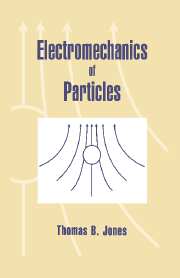Book contents
- Frontmatter
- Contents
- Preface
- Nomenclature
- 1 Introduction
- 2 Fundamentals
- 3 Dielectrophoresis and magnetophoresis
- 4 Particle rotation
- 5 Orientation of nonspherical particles
- 6 Theory of particle chains
- 7 Force interactions between particles
- Appendix A Analogies between electrostatic, conduction, and magnetostatic problems
- Appendix B Review of linear multipoles
- Appendix C Models for layered spherical particles
- Appendix D Transient response of ohmic dielectric sphere to a suddenly applied DC electric field
- Appendix E Relationship of DEP and ROT spectra
- Appendix F General multipolar theory
- Appendix G Induced effective moment of dielectric ellipsoid
- References
- Index
Preface
Published online by Cambridge University Press: 02 December 2009
- Frontmatter
- Contents
- Preface
- Nomenclature
- 1 Introduction
- 2 Fundamentals
- 3 Dielectrophoresis and magnetophoresis
- 4 Particle rotation
- 5 Orientation of nonspherical particles
- 6 Theory of particle chains
- 7 Force interactions between particles
- Appendix A Analogies between electrostatic, conduction, and magnetostatic problems
- Appendix B Review of linear multipoles
- Appendix C Models for layered spherical particles
- Appendix D Transient response of ohmic dielectric sphere to a suddenly applied DC electric field
- Appendix E Relationship of DEP and ROT spectra
- Appendix F General multipolar theory
- Appendix G Induced effective moment of dielectric ellipsoid
- References
- Index
Summary
As a consequence of their electrical and/or magnetic properties, all particles experience forces and torques when subjected to electric and/or magnetic fields. Furthermore, when they are electrically charged, polarized, or magnetized, closely spaced particles often exhibit strong mutual interactions. In this book, I focus on these particle–field interactions, referred to collectively as particle electromechanics, by delineating common phenomenology and by developing simple yet general models useful in predicting electrically and magnetically coupled mechanics. The objective is to bring together diverse examples of field–particle interactions from many technologies and to provide a common framework for understanding the relevant electromechanical phenomena. It may disappoint some readers to learn that, despite the rather general definition offered for particle electromechanics, I restrict attention to particles in the size range from approximately 1 micron (10−6 m) to 1 millimeter (10−3 m). Though many of the ideas developed here indeed carry over into the domain of ultrafine particles, the lower limit recognizes that other phenomena, such as van der Waals forces and thermal (Brownian) motion, become important below one micron. The upper limit is consistent with a reasonable definition for a classical particle.
Chapter 1 introduces the subject, provides a definition for particle electromechanics, and adds some caveats to inform the reader of the book's limitations. Chapter 2 unveils the fundamental effective moment concept employed throughout the book in the calculation of electromechanical forces and torques. It also uses multipolar expansion methods to solve for the induced moments for a particle experiencing a strongly nonuniform field and exploits the analogy between electrostatic and magnetostatic problems to reveal how the results for a dielectric particle can be applied to a magnetizable particle.
- Type
- Chapter
- Information
- Electromechanics of Particles , pp. xiii - xviPublisher: Cambridge University PressPrint publication year: 1995



